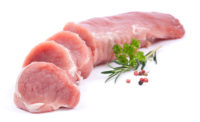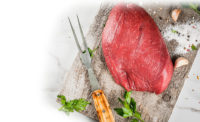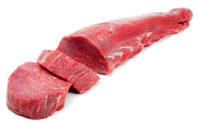Marketing whole-muscle


|
Fortunately, sales of whole-muscle cuts in pork and beef have remained steady. The top-selling pork products, according to the National Pork Board, include the boneless top loin chop, as well as the tenderloin. On the beef side, the ribeye, tenderloin and pot roast are among the most popular products, reports the National Cattleman’s Beef Association. Along with strong consumer loyalty, the meat industry has made a considerable effort to maintain popularity of its top-selling products.
“I am seeing the industry taking a positive outlook on whole-muscle foods,” says Chris Calkins, professor of animal science at the University of Nebraska. “On the fresh-meat side, I hear of more processors willing to offer individual muscles and/or further-fabricated subprimals. Tyson’s offer of a four-piece chuck roll comes to mind as an excellent example.”
At the retail level, one issue that the NCBA has had to deal with is the increased carcass size of cattle. Many customers have become frustrated with middle meat cuts because of larger portion sizes, higher prices and thinner cuts. The Beef Alternative Merchandising Program, sponsored by The Beef Checkoff, was designed to address the increased size of the cattle as well as the consumer’s need for more correctly proportioned products.
“It’s focused on three subprimals — the ribeye, the strip loin and the top sirloin,” says Trevor Amen, director of market intelligence and veal marketing for the NCBA. “It’s basically an innovative way to break down those individual muscles into smaller portion sizes.”
For instance, the top of the ribeye muscle can be peeled off and sold as an individual product, leaving the body of the ribeye, explains Amen. That part can be split in half or sold as an individual cut. The resulting filets are smaller and thicker in size, adding another option to the meat case.
“These cuts definitely don’t replace traditional cuts but rather give that option to consumers who are looking for it, adding variety in the meat case,” Amen says.
Another recent trend ties in with the consumer becoming increasingly savvy at the grocery store. Along with keeping a close eye on special prices, coupons, value packages and bulk purchases, some shoppers are stepping into the role of the butcher. Rather than picking up a package of steaks, they are, for example, buying the entire ribeye in a vacuum package and portioning it themselves. With the cost-per-pound savings that come with buying a larger portion, a consumer can stock a freezer or serve steaks for a party and while saving money in the process.
“We’ve developed marketing materials for the retail level, as far as cutting demonstrations, online videos and consumer brochures,” notes Amen. “Consumers like the idea of cutting their own steaks and roasts, and we have provided them with all of the educational means necessary, with on-pack labels and online resources where they can educate themselves.”
The National Pork Board has been pushing its new “Be Inspired” slogan, giving pork consumers positive “permission” to enjoy the product more frequently and to try new cuts or products. Last year, the USDA lowered the end-point cooking temperature for pork chops, steaks and roasts. The Pork Board also has been quick to promote that change, reaching out to consumers who may have had unsatisfying experience with dried-out whole-muscle cuts in the past.
“Supported with the 145 message that allows for a range of doneness, we are effectively educating customers to not overcook the product,” says Jarrod Sutton, assistant vice president, channel marketing, for the Pork Board. “Lower temperature equals a more juicy, more flavorful, better eating experience.”
To be successful at the retail level, the beef and pork products must be processed to the highest standards. Sutton notes that proper product handling is a necessity, as is maintaining the cool temperature during processing and distribution.
“Many processing facilities are utilizing the new technology of blast chilling, which preserves a higher level of pH, meaning the meat will retain moisture better, resulting in a better eating experience,” he says.
Along with maintaining microbiological quality of the meat, Calkins adds that keeping the product at a proper storage temperature also stabilizes the color of the cuts. With meat color being such an important characteristic to consumers, any product with even a hint of brown coloring risks being sold at a severe discount or left unsold. Calkins also says he encourages proper packaging — using a high-quality vacuum seal in an appropriately sized bag.
“Aging is important for many of the new single-muscle items, and one recommendation does not fit all,” he adds.
Looking for a reprint of this article?
From high-res PDFs to custom plaques, order your copy today!








